Background
Celsa is a company specialized in the manufacturing of steel products, among which are laminates steel bars.
The goals of this company are a continuous improvement in terms of product quality, cost efficiency and customer service levels.
The Challenge
Celsa is looking for a system to measure if the produced laminated steel bars comply with the expected tolerance in straightness. The system must be able to measure the straightness with 6σ reliability, monitor the collected information and identify values out of tolerance.
Actual Specifications
The most common profiles used are IPE160, IPE140, IPE120, IPE100, IPE80, IPN160, IPN140, IPN120, IPN100, IPN80, UPN160-80, LPN100-40. The current process to measure the straightness of the bars consists in stopping the production line and execute a manual measurement.
First the “lateral” straightness is measured leaving the bar as it comes from the production line. The bar is then tipped 90º (as in picture "Sagitta Measurement") to check for the “vertical” straightness.
A video and more pictures are provided so that the solvers can understand the current process and available space.
The typical admitted tolerance is indicated in the attached file “Typical Tolerance” for the most common profiles and lengths.
The current process is as follows:
1. Shear for cutting the cold bars. According to the kind of product, the shear can cut from 1 to 7 bars (e.g. for the 40 mm angled bars).
2. Roller to move the bars from the shear to the stacking area
3. Rotating arm to load the bars from the roller and leave them in the chain system that moves the bars to the stacking machine
4. First section of chains where bars of the same length are aligned
5. Second section of chains, transport
6. Third section of chains, transport and the current location where the manual measurement is done while the production line is stopped.
7. Fourth section of chains, transport
8. Fifth section of chains, transport
9. Three different stacking machines. By combining two of the machines, a max length of 18 meters can be produced.
What the Client Is Looking for
The Client is looking for a solution that:
- measures straightness and controls for tolerance compliance in a continuous way so that the installation mustn’t be stopped for the manual measurement, meaning up to 3% of loss in productivity.
- send the collected information to a measurement program that saves the information and generates an alarm in case of non-conformity to the expected tolerance
- measures both lateral and vertical straightness (as described earlier and in document "Typical Tolerance"). The proposed solution will require the 90º tipping to measure both straightness, so the system must be able to execute the tipping to measure and to leave the bar in its original position in an automatized way.
This is a 1-round tournament with the following submissions:
- First round
o A 3-page PDF document including:
o Brief description / sketches of the proposed design
o Supporting evidence on how your proposal will solve the problem
o Materials cost
o In addition you can add an attached document to support your solution
Evaluation Criteria
- Precision of the measurement (within expected tolerance)
- Lower estimated costs (total investment shall be less than € 100,000)
- Easy to add to the existing installation
- Technical solution
- Feasibility evidence
- Innovation factor
Timeline
This is a 1-round tournament with the following timings
1st round – 8 weeks+ 3 weeks for evaluation



